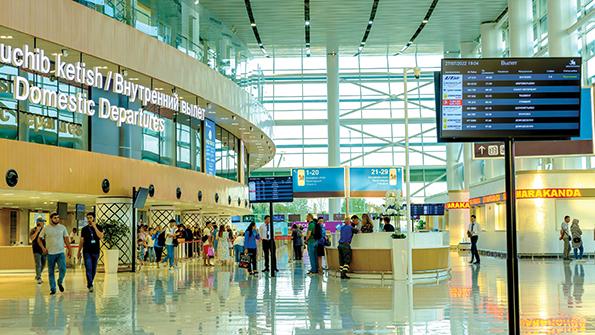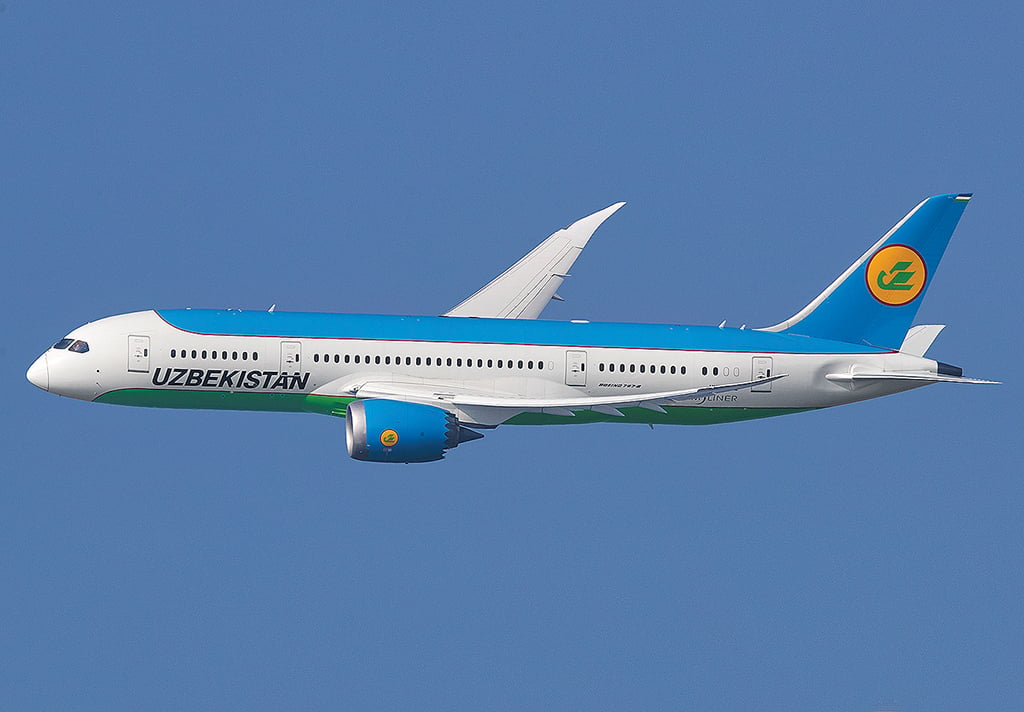Central Asian Airlines Enjoy Quick Post-COVID Recovery

Samarkand Airport owner Air Marakanda has set up Air Samarkand, which plans to launch international flights from its home city to Russia, the Middle East and India with its Airbus A320 fleet in spring 2023.
Airlines from Central Asia are recovering quickly after the pandemic-related downturn, even though some are strongly dependent on Russian destinations. And Russian airspace restrictions due to its invasion of Ukraine may provide opportunities to increase market share on transit between Asia and Europe.
Central Asian markets have rebuilt 88% of their 2019 traffic, comparable to U.S. domestic performance, surpassing the recovery rate for intra-European traffic, Askhat Torshin, Lufthansa Consulting’s Commonwealth of Independent States regional representative, said at the Asia Connect conference in Samarkand, Uzbekistan, on Dec 14. As of June 2022, Kyrgyzstan and Tajikistan had outperformed their peers and increased air traffic by 12% and 4% above pre-pandemic levels, respectively, he noted. Uzbekistan has recovered 88%, followed by 78% in Kazakhstan. Turkmenistan was the only country in the region that still had its air traffic at well below 2019 figures, down by 21%.
- Two new local carriers in Uzbekistan are expected to start operating this year
- Wizz Air Abu Dhabi now serving Uzbekistan
Rano Djurayeva, CEO of Uzbekistan Airports, which governs the country’s 11 international air gateways, told Aviation Week before and at the conference that air traffic grew by 38% compared with 2021. She expects passenger traffic to grow to 7 million in 2022 versus 6.7 million in 2019. Uzbekistan Airports’ basic forecast shows that the country’s air traffic could reach almost 28 million passengers by 2035.
“Nobody expected that our airline could reach pre-pandemic traffic figures in such a short time,” Sardor Irmukhamedov, director of the department of tariffs and commercial agreements at Uzbekistan Airways, the country’s largest airline, said at the conference.

In 2022, the carrier resumed all the routes that had been suspended in 2020 and launched new flights. It plans to add Jakarta, Indonesia, and increase frequencies on existing routes in 2023. The airline’s fleet grew to 32 aircraft by the end of 2022 with the addition of five Airbus A321neos.
Growing economic activity and liberalization of air regulations in Uzbekistan present opportunities for new carriers both inside and outside the country. At least two new local carriers are expected to start operations in 2023. One of them—Silk Avia—is a subsidiary of Uzbekistan Airports. With a dozen ATR 72 turboprops, it plans to replace Uzbekistan Airways on domestic routes, allowing the government-owned carrier to focus on international air services, Djurayeva said.
Another startup, Air Samarkand, set up by the private owner of Samarkand International Airport’s operator Air Marakanda, plans to launch international flights from its home city to Russia, the Middle East and India with its Airbus A320 fleet this spring.
Wizz Air Abu Dhabi has also launched services to Uzbekistan, with two weekly flights to Samarkand from Dec. 14. The low-cost carrier also plans to soon add three weekly flights to the capital Tashkent. It already serves two destinations in neighboring Kazakhstan—the capital Astana and Almaty.
The number of airlines operating at Tashkent International Airport has increased to 52 from 22 within a year, Djurayeva said, leading to revised expansion plans for the country’s airports. Uzbekistan Airports launched operations of the new airport terminal in Samarkand last March and plans to renovate the airports in two other tourist centers—Bukhara and Urgench—in 2023-24.
However, air operators from Uzbekistan and some neighboring countries strongly rely on the Russian market, mostly because of labor migration. Russian destinations account for 52% of Uzbekistan’s traffic, data from Lufthansa Consulting shows. This share is even higher for Kyrgyzstan (67%) and Tajikistan (90%).
Torshin points out that local carriers managed to increase their traffic to Russia in 2022 as Russian carriers withdrew or cut their capacities due to the shortage of aircraft suitable for international services. On the other hand, Central Asia remains one of the few remaining air gateways to Russia after its air connectivity to the Western world was disrupted by the invasion of Ukraine.
Kazakhstan decreased its share of Russian traffic to 11% in 2022 as the country’s largest carrier, Air Astana, suspended flights into and over Russia in March. The airline, together with major local rival Scat Airlines, is now mostly focused on domestic services.
Dependence on the Russian market could pose a risk to Central Asian carriers if political decisions limit the operational ability of foreign carriers to operate to Russia, Torshin warned. He advised regional carriers to diversify their flight networks and follow Uzbekistan’s example of seeking to attract international tourists.
Another opportunity—as long as Western carriers are banned from Russian airspace—would be in developing transit traffic between Europe and Asia, increasing flight times and expenses on Asian routes. The region can offer one of the shortest paths that avoid Siberian airspace, Lufthansa Consulting says, but the ground infrastructure would need to be improved.
Uzbekistan Airports has already doubled the capacity of its main international hub, Tashkent Airport, to 1,200 passengers per hour in 2021 and plans to double it again. But the gateway will run out of airspace capacity by 2027 and the capital will need a new international airport, Djurayeva said.
Uzbekistan Airways already flies from Samarkand to Istanbul and plans to launch new international flights from the country’s other airports: from Namangan to Russian destinations, from Fergana to the United Arab Emirates and from Urgench to some European destinations. It is also the only carrier in the region with long-range capacity—six Boeing 787s, which are suitable for transatlantic flights.
Kazakhstan will be able to improve its transit potential in 2024-25 when Almaty International Airport plans to open a new international terminal, Torshin said, while Air Astana is set to receive three Boeing 787s to launch U.S. operations.




